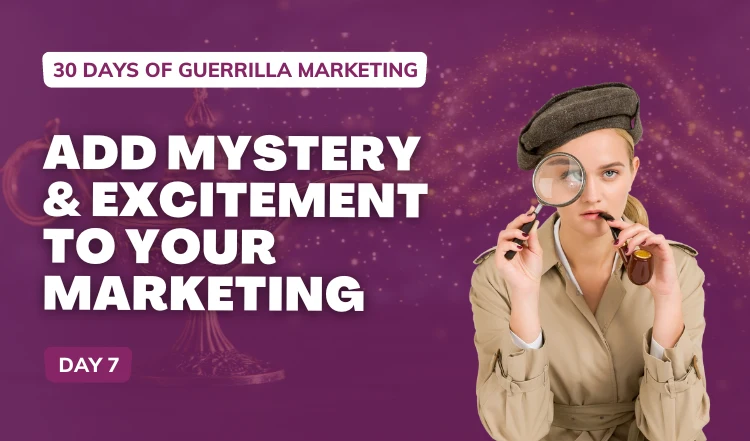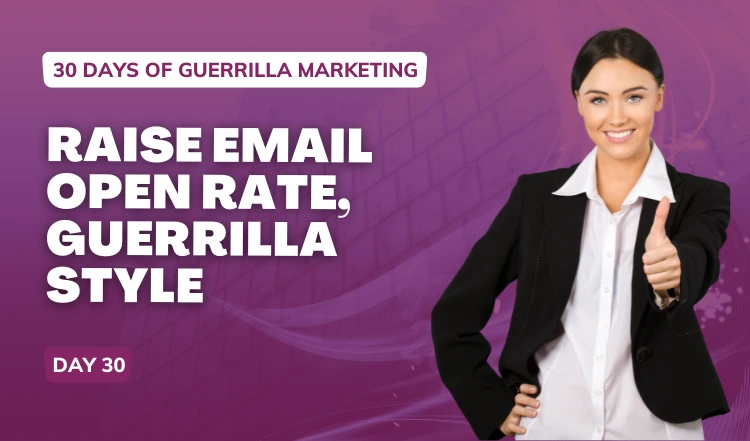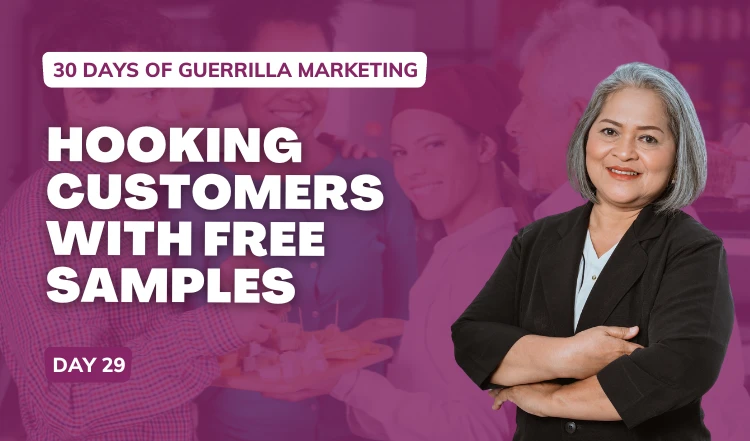And here we are on day seven of our 30 Days of Guerrilla Marketing. Today, we dive into the captivating world of mystery and excitement in marketing. Adding an element of intrigue and curiosity to your campaigns can create a buzz, pique interest, and drive engagement, all while adding followers and, inevitably, customers.
In this article, we’ll explore strategies to apply mystery and excitement to your marketing to help you leave a lasting impression on your audience.
While this technique may not initially come across as a guerrilla marketing tactic, it certainly is when used properly. In fact, when used strategically, it’s like unlocking the secrets to a missing impactful and thrilling marketing approach!
10 Ways To Add Intrigue & Mystery To Your Marketing
- Teaser Campaigns
- Create suspense and anticipation by launching teaser campaigns before unveiling a new product, service, or event.
- Use cryptic messages, intriguing visuals, and countdowns to build excitement and leave your audience curious about what’s to come.
- Limited-time Offers and Flash Sales
- Create a sense of urgency and exclusivity by offering limited-time discounts, flash sales, or exclusive deals.
- By emphasizing scarcity and time-sensitive opportunities, you can instill a feeling of excitement and encourage immediate action from your audience.
- Interactive Contests and Giveaways
- Engage your audience through interactive contests or giveaways that involve solving puzzles, riddles, or participating in challenges.
- Incorporate elements of mystery and excitement, rewarding winners with unique experiences, exclusive access, or sought-after prizes.
- Hidden Clues and Easter Eggs
- Infuse your marketing materials, website, or social media channels with hidden clues, Easter eggs, or secret messages.
- Encourage your audience to actively search for these hidden gems, creating a sense of discovery and fostering deeper engagement with your brand.
- Unveiling Surprises
- Surprise your audience with unexpected announcements, product releases, or updates.
- Unveil new features, collaborations, or initiatives in a way that generates intrigue and leaves your audience eager to learn more.
- Storytelling and Narrative
- Craft compelling narratives around your brand, products, or campaigns to create an immersive experience for your audience.
- Develop intriguing storylines that keep them engaged and eager to uncover the next chapter.
- Influencer Partnerships
- Collaborate with influencers or thought leaders in your industry to amplify the mystery and excitement around your brand.
- Utilize their platforms to tease upcoming launches, create buzz, and leverage their credibility to generate interest.
- Experiential Marketing
- Create immersive experiences or events that immerse your audience in an interactive and mysterious world.
- Combine elements like sensory engagement, augmented reality, or live performances to make a lasting impression and leave them wanting more.
- Engaging Visuals and Design
- Leverage captivating visuals, intriguing design elements, and enigmatic imagery to evoke curiosity and capture attention.
- Use compelling graphics, videos, or animations that hint at a hidden story or invite viewers to explore further.
- Multichannel Marketing
- Implement a cohesive multichannel marketing approach to maximize the impact of your mystery and excitement campaigns.
- Coordinate your efforts across social media, email newsletters, website, and offline channels to create a unified and immersive experience.
8 Real Examples of Businesses That Used Mystery in Their Marketing
Here are a few real examples of businesses, that aren’t huge, who have successfully used mystery and excitement in their marketing campaigns and saw real exciting results:
Cards Against Humanity
Cards Against Humanity, a popular party game company, launched a mystery campaign called “Bigger Blacker Box.”
They released a limited edition of their game, but the contents of the box remained a mystery.
This generated significant buzz and anticipation among their audience, leading to increased sales and engagement. The element of mystery added an extra layer of excitement to their marketing, making it a memorable experience for their customers.
Tattly
Tattly, a temporary tattoo company, introduced a mystery pack where customers would receive a surprise assortment of tattoos with their order.
Customers loved the element of surprise, not knowing which designs they would receive.
This strategy not only boosted sales, but also encouraged customers to share their surprise tattoos on social media, generating additional exposure and creating a sense of excitement around the brand.
Everlane
Everlane, an online clothing retailer, created a mystery campaign called “Choose What You Pay.”
They presented their customers with a selection of products where they could choose the price they wanted to pay within a given range. This unconventional approach created excitement and engaged customers uniquely.
It also generated a buzz around the brand, attracted new customers, and fostered a sense of loyalty among existing ones.
Pop Chart
Pop Chart is a company that creates beautifully designed infographics and prints. To generate excitement and engagement, they launched a “Mystery Print” campaign, where customers could purchase a limited edition print without knowing the exact design they would receive.
This created anticipation and a sense of surprise among customers, encouraging them to take a chance on a unique piece of artwork.
The Oatmeal
The Oatmeal, a popular webcomic, launched a mystery box campaign called “The Blerch Box.” Fans could sign up for a subscription box filled with quirky and exclusive merchandise related to The Oatmeal’s characters and themes.
By offering a mystery box, The Oatmeal created anticipation and excitement among their loyal fan base, driving both sales and engagement.
Julep
Julep, a beauty company, introduced a “Mystery Box” promotion where customers could purchase a box of beauty products at a discounted price without knowing the specific contents.
The mystery aspect of the campaign intrigued customers and added an element of surprise to their purchase, enhancing the overall experience and generating excitement around the brand.
Threadless
Threadless, an online t-shirt marketplace, organized a “Mystery Sale” event where customers could purchase mystery t-shirt packs at a discounted price.
Customers could select their preferred size, but the designs would be a surprise.
This created a sense of excitement and intrigue, enticing customers to participate in the sale and discover new designs they might not have chosen otherwise.
Scentbird
Scentbird, a fragrance subscription service, offered a “Mystery Fragrance” option as part of their subscription plan. Subscribers could opt to receive a surprise fragrance each month, carefully selected based on their preferences.
This added an element of excitement and discovery to the subscription experience, allowing customers to try new scents and expand their fragrance collection.
These examples demonstrate how businesses have used mystery and excitement in their marketing to promote their products or services.
By incorporating surprise elements, such as mystery prints, mystery boxes, or surprise selections, they have effectively engaged their audience, generated anticipation, and added a touch of excitement to the customer experience.





